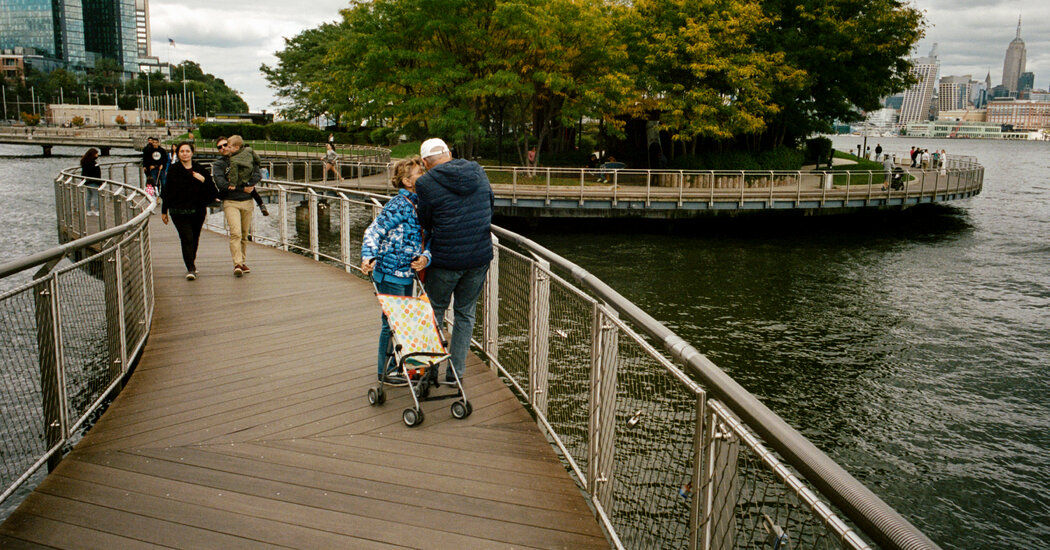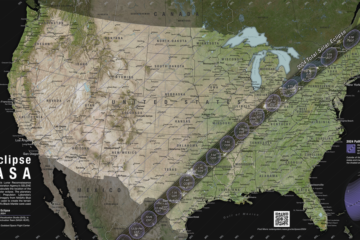[ad_1]
Good morning. It’s Monday. We’ll look at the contrasts between two flood-prone cities on the Hudson River — New York and Hoboken, N.J. — in an era when climate change is bringing us more intense storms.
This is a story about two flood-prone cities on the Hudson River — New York and Hoboken, N.J.
Hoboken has prepared for storms in the era of climate change by building water-absorbing infrastructure that protects against intense storms with heavy rain. Our architecture critic, Michael Kimmelman, says Hoboken learned from Hurricane Sandy, which, in 2012, left the city underwater for days and caused more than $110 million worth of property damage.
Eleven years later, Hoboken looks like a climate change success story. During an early-morning storm in September, in a single hour, which happened to coincide with high tide, 1.44 inches of rain fell; some 3.5 inches fell before the storm let up. But Hoboken was largely unscathed. I asked Michael to explain why, and to discuss what sets Hoboken apart from New York City in dealing with heavy rain.
Let’s look back to that storm in September. How was it different in Hoboken than it was across the river in New York City?
In Brooklyn, you had people wading through thigh-high water and basements that were flooding. Some subway stations had to shut down for a while.
In Hoboken, the storm was a relatively minor event. The Police Department did not get any more calls than it usually gets on a Friday morning.
Part of the difference was preparedness. Mayor Eric Adams had not told New Yorkers that there was a storm coming. In Hoboken, officials had issued a number of warnings on the previous days.
Preparedness also affected the ability to bounce back. Hoboken was pretty much fine by the middle of that afternoon. Schools let out on time, and an arts festival that’s a big moneymaker went on on schedule.
But Hoboken began preparing for extreme weather long before that day, didn’t it?
Yes, Hoboken is a lesson for cities like New York because Hoboken has spent the last decade-plus trying seriously to anticipate and to build for a changing climate and the problems of storms and rain and high tides.
Hoboken took advantage of a federal program, called Rebuild by Design that the Obama administration started after Hurricane Sandy, that seeded projects in areas that had been damaged — projects to mitigate flooding that benefit the community in other ways.
How so?
A big reason Hoboken did not flood in the way New York did was that Hoboken had invested in new parks that include giant cisterns and collection ponds and pumps underground. When the rain fell, the parks could help hold the water and then expel it later. One new park, called ResilienCity Park, collected some 1.4 million gallons of water that would have flowed into the street.
So residents got something that benefits them 365 days a year: several nice parks. But as part of the deal, they got something for those rare but crucial days when there’s an extreme rain event that threatens to do what Sandy did, which was to cause $110 million in property damage in Hoboken alone.
Hoboken’s approach was different from the flood walls and breakwaters that New York City is spending billions to build. Is Hoboken’s better?
There can hardly be a less sexy or appealing topic than fixing the sewers, but unfortunately there can hardly be a more crucial, existential problem for a city when the sewers were not built to deal with the current climate situation. That’s New York’s problem, although New York has been taking steps to improve its sewer system.
In Hoboken, the sewers were upgraded, and many of the streets were remade so there would be less likelihood of pedestrian accidents. But Hoboken’s approach was to do a twofer: At the same time, it put in gardens and porous surfaces along those streets that would collect water when there was rain.
You pointed out that Mayor Adams cut $75 million from the budget for New York’s parks department. Why was that a bad decision?
It’s understandable that everyone would need to tighten belts, and that the mayor would ask everyone to save money. Parks are often thought of as a luxury, not an essential part of civic welfare, but they are, frankly, as important as almost anything else because they are not just places where people can go to relax.
Given the reality of climate change and our need to deal with storms that are becoming more extreme, our parks collect as much water as half a billion dollars’ worth of infrastructure that New York would have to build.
That’s a lot.
Yes. In the long run, letting our parks deteriorate is going to cost a lot more.
It’s a very American thing. We spend a lot more to recover from emergencies than we would spend if we invested early and upfront in prevention and adaptation.
In the Netherlands, you can’t get property insurance against flooding because it’s the government’s responsibility to do everything possible to make sure you will not flood. In America, you buy flood insurance and build a house in a flood zone and expect someone else to pay for it if it gets ruined — to clean up the mess afterward.
Because of climate change and more extreme weather, insurance companies are no longer as willing to insure properties at risk for flooding as they were before, so I think eventually Americans are going to have to think ahead. But it’s not the way we do things.
Weather
Enjoy a sunny day with a high of 50 degrees. At night, temperatures will drop to the low 40s.
ALTERNATE-SIDE PARKING
In effect until Nov. 23 (Thanksgiving Day).
METROPOLITAN diary
Inside Out
Dear Diary:
I was walking my dog along York Avenue near East 70th Street early on a Sunday. There weren’t many people around.
I realized that I had my shirt on inside out and began to feel uncomfortable. Even though there were few people around, I was sure that everyone was staring at me.
What to do? I started to look for an alleyway where I could change quickly. I didn’t find one; even if I had, I am too timid to have tried changing my shirt in public.
My dog could not have cared less about my dilemma and insisted on continuing to pull me forward. Finally, when we got to around East 73rd Street, I noticed a young couple loading up a car. I decided to approach them.
“I have a very strange request,” I said. “Would you be OK if I got into your car and put my shirt right side out?”
[ad_2]
Source link




